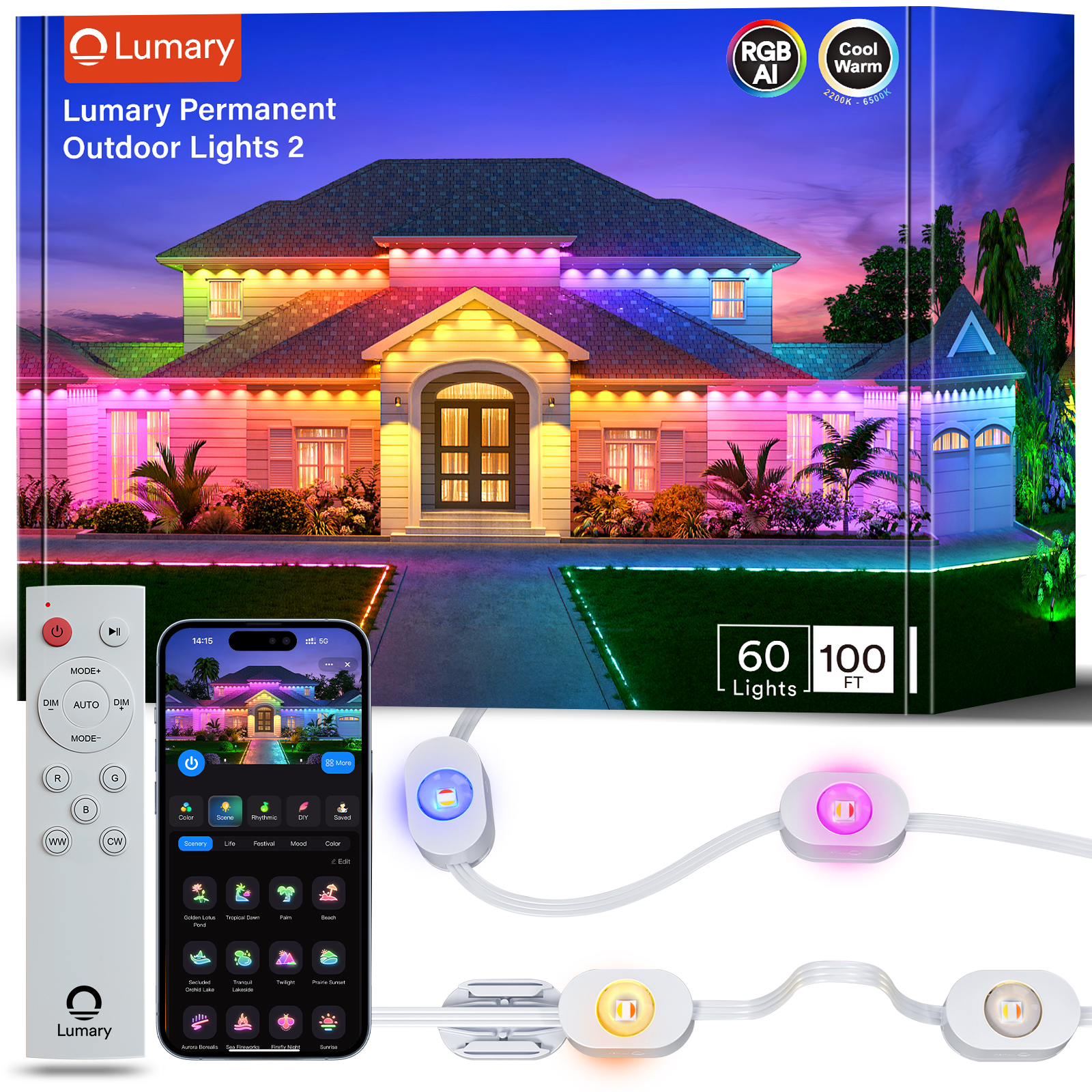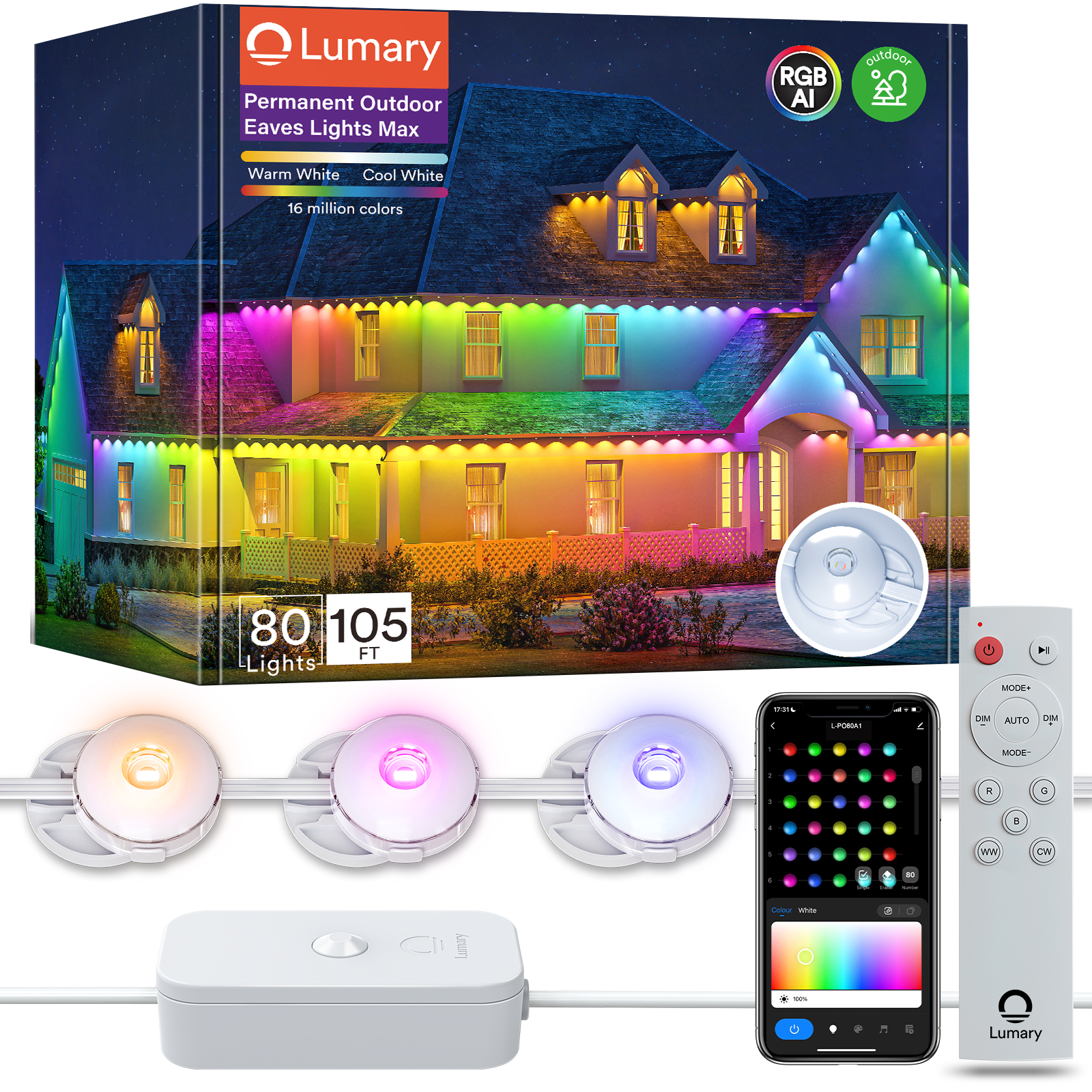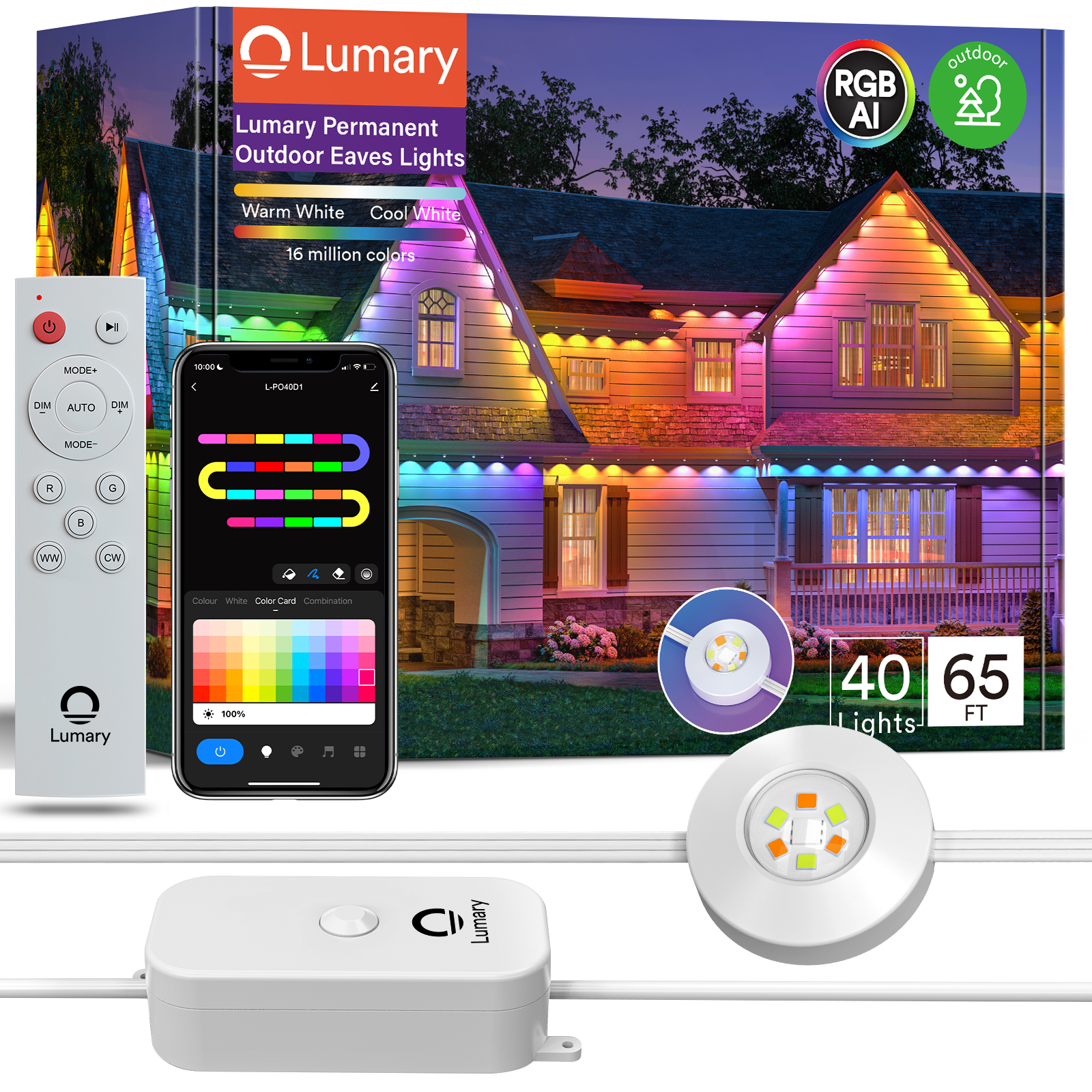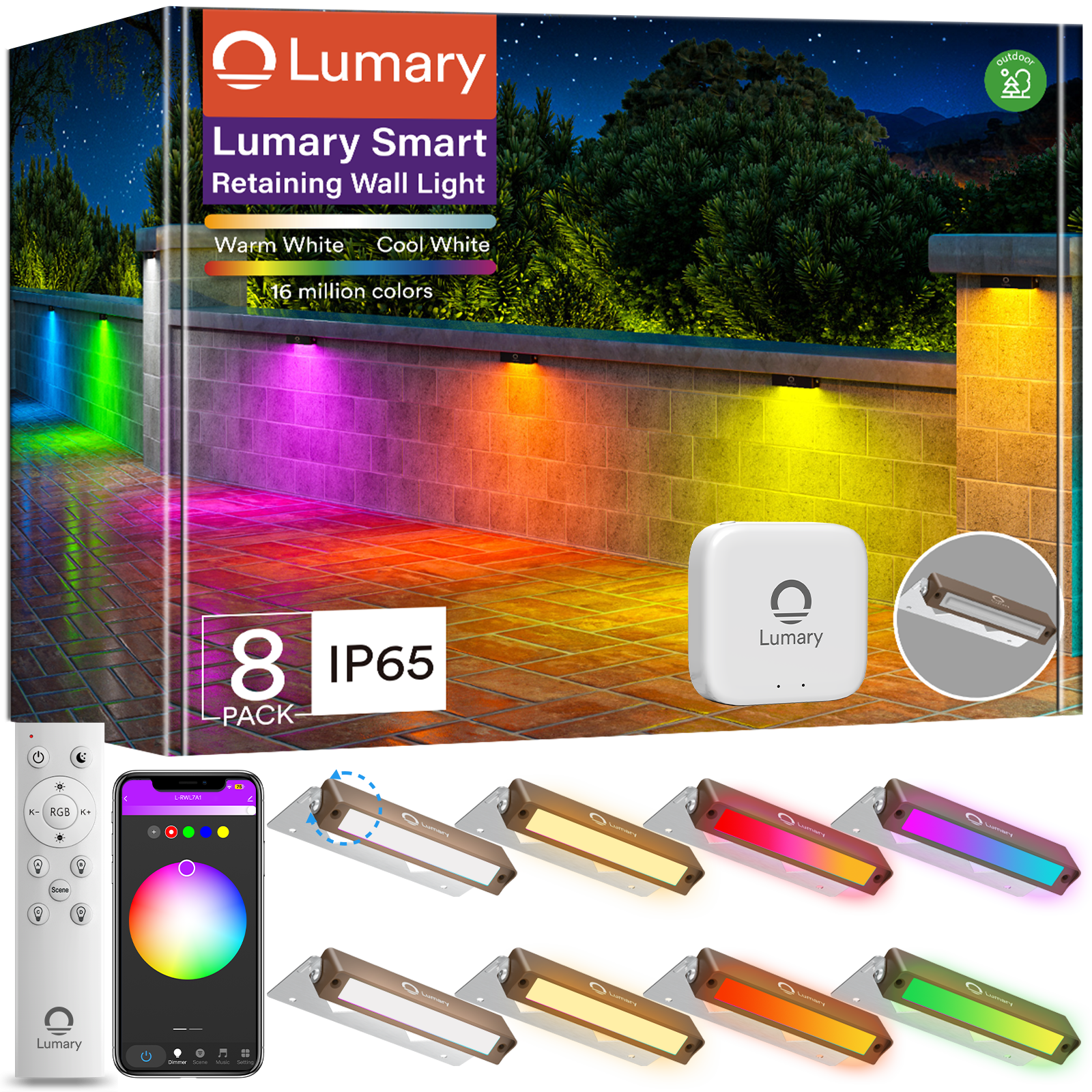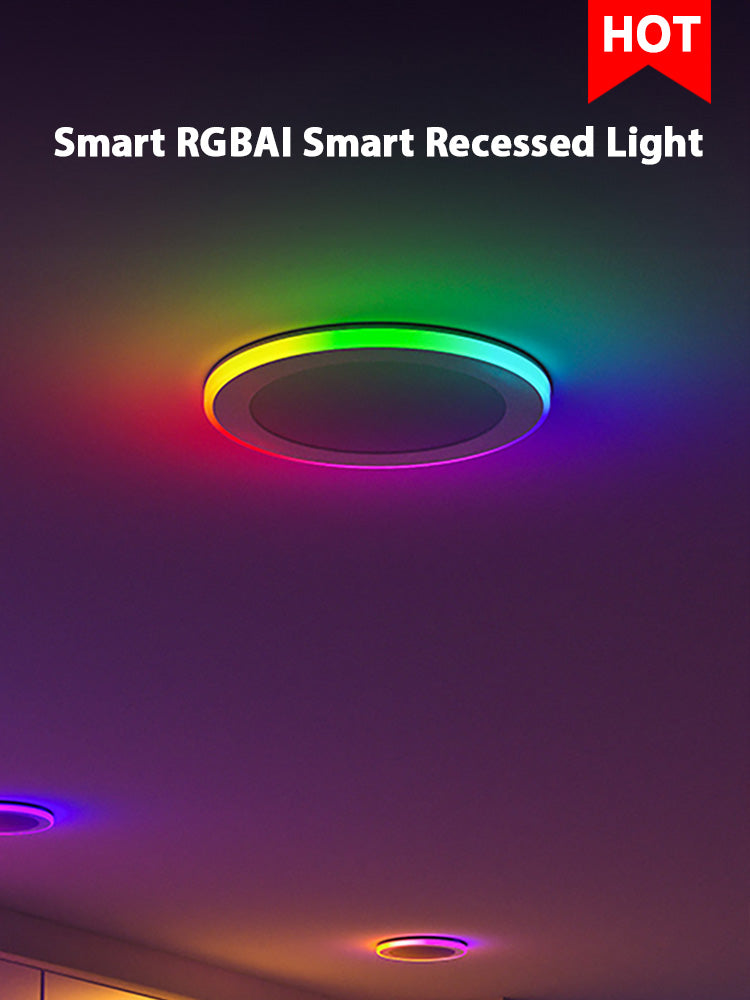If you want the most modern and efficient recessed lighting, canless lights are often best. Canless recessed lights are easy to put in. They need smaller holes in the ceiling and less space above. These lights have built-in LED chips. The chips use less energy and last a long time. Traditional recessed lights are bigger and need more space. They give you more style choices. But they can waste energy because of air leaks. The best light for you depends on how you want to install it, save energy, spend money, and pick a design.
|
Aspect |
Canless Lights |
Traditional Recessed Lights |
|---|---|---|
|
Installation |
Easy, needs less space |
Harder, needs bigger holes |
|
Efficiency |
Very good, built-in LEDs |
Depends on bulb, can waste energy |
|
Cost |
Costs more at first, saves money later |
Cheaper at first, costs more to keep up |
|
Design |
Simple and modern look |
More choices for trim and bulbs |
Key Takeaways
-
Canless recessed lights are easy to put in. They need only small holes in the ceiling. They have built-in LEDs that use less energy. These LEDs also last a long time.
-
Traditional recessed lights give you more bulb and trim options. But they need bigger holes in the ceiling. They also need more space above the ceiling.
-
Canless lights are good for small or low ceilings. Traditional lights are better for new buildings with deep ceilings.
-
Canless lights cost more at first. But they save money when you install them. They also lower your energy bills over time.
-
Smart canless lights let you change colors and brightness easily. They help make your home look modern. They also help save energy.

Types of Recessed Lights
There are different kinds of recessed lights. Each type works best in certain places. You can put them in ceilings, walls, or even the ground. Most people use ceiling recessed lights. You see these in kitchens, bedrooms, and offices. Some lights go in walls to make a room look nice. Others go in the ground for paths or driveways.
Here is a table that shows how recessed lights are grouped:
|
Category Basis |
Main Types of Recessed Lights |
Description / Applications |
|---|---|---|
|
Installation Location |
Ceiling Recessed Lights |
Flush with ceiling, used for general lighting in many rooms |
|
|
Wall Recessed Lights |
Installed in walls for accent or task lighting |
|
|
In-Ground Recessed Lights |
Installed in ground for pathways and outdoor safety |
|
Application |
Adjustable Recessed Lighting |
Swivel or gimbal mounts to direct light where you need it |
|
|
Remodel Recessed Lighting |
Designed for retrofits, clips into drywall, good for older homes |
|
Housing Design |
Low-Profile Recessed Lighting |
Shallow fixtures for tight spaces |
|
|
IC-Rated Housing Recessed Lighting |
Safe for contact with insulation, prevents fire hazards |
|
|
Airtight Housing Recessed Lighting |
Prevents air leaks, improves energy efficiency |
|
|
Slope Housing Recessed Lighting |
Fits angled ceilings or walls |
|
Trim Types |
Baffle, Reflector, Open, Pinhole, Gimbal, Eyeball, Wall-Wash, Shower Trim |
Different trims for glare control, brightness, and special uses |
Canless Recessed Lighting
Canless recessed lighting is very popular now. This kind has the housing, trim, and light all together. You do not need a big can above the ceiling. You can put these lights right into the ceiling. This makes them fast and simple to install. Canless recessed lighting uses LED technology. These lights are bright but use less power. The design is thin and fits in small spaces. They are great for homes with low ceilings or little attic space.
Some important things about canless recessed lighting are:
-
All parts are in one piece
-
Goes straight into the ceiling
-
Uses energy-saving LEDs
-
Airtight and safe with insulation
-
Looks modern and slim
When the light stops working, you change the whole fixture. You do not just change the bulb like with other lights.
Traditional Recessed Lights
Traditional can lighting is also called can recessed lighting. It uses a separate can that sits above the ceiling. You put in the can first, then add the trim and bulb. This type lets you pick from more bulbs and trim styles. You can use incandescent, halogen, fluorescent, or LED bulbs. Traditional recessed lighting is best for new buildings or rooms with deep ceilings. You can change the bulb when it burns out. This gives you more choices.
Tip: If you want to control how your lights look and where they shine, traditional recessed lights give you more options.

Pros and Cons
Canless Lights: Pros & Cons
Canless recessed lighting has many good points for homes. These lights look modern and save space in your ceiling. They use built-in LED chips, so you use less energy and pay lower bills. You do not need a big can above the ceiling. This makes it easier to put them in tight spots. Canless lights work well in rooms with low ceilings or small attics. Many people like their simple style and how they blend into the ceiling.
Pros of canless recessed lighting:
-
You install them fast because they need smaller holes and fewer parts.
-
You save energy with built-in LEDs, which last longer and use less power.
-
You get a slim, modern look that fits many room styles.
-
You avoid air leaks, which helps keep your home comfortable.
-
You can pick smart models and control them with your phone or voice.
Cons of canless recessed lighting:
-
You must replace the whole fixture when the light stops working, not just the bulb.
-
You pay more at first, especially for smart models.
-
You do not get incandescent lighting options, so you miss out on the warmth some bulbs provide.
-
Installation steps change by brand, which can confuse you if you try to install them yourself.
-
You may find fewer choices for adjusting the direction of the light.
Tip: If you want a quick upgrade and care about energy efficiency, canless lights work well for most homes.
|
Feature |
Canless Lights |
|---|---|
|
Installation |
Fast, needs less space |
|
Energy Efficiency |
Very high |
|
Lifespan |
Long (LED chips) |
|
Heat Output |
Low |
|
Flexibility |
Limited adjustment |
|
Maintenance |
Replace whole fixture |
|
Upfront Cost |
Higher |
Traditional Recessed Lights: Pros & Cons
Traditional recessed lights have been used for a long time. You get more choices for bulbs and trims, so you can match your style. You can use LED, fluorescent, or incandescent bulbs. LED bulbs are best for saving energy. You change the bulb when it burns out, so it is easy to take care of these lights. These lights work well in new buildings or rooms with deep ceilings.
Pros of can recessed lighting:
-
You pick from many bulb types and trim styles.
-
You change bulbs easily, which saves time and money.
-
You create different lighting zones and highlight features in your room.
-
You enjoy a sleek look that blends into the ceiling.
-
You save space and make rooms feel bigger.
-
You get focused, glare-free light that improves ambiance.
-
You benefit from long-lasting LED bulbs, which lower your utility bills.
Cons of can recessed lighting:
-
You deal with more parts, which makes installation harder.
-
You may face higher long-term costs if you use incandescent or fluorescent bulbs.
-
You clean more often because dust collects inside the can.
-
You risk air leaks, which can waste energy and raise heating or cooling costs.
-
You may find some bulb types, like incandescent, use more energy and do not last as long.
-
Fluorescent bulbs contain mercury, which is not safe for the environment.
Note: If you want more control over your lighting and like to change bulbs or trims, traditional recessed lights give you flexibility.
|
Feature |
Traditional Recessed Lights |
|---|---|
|
Installation |
More complex |
|
Energy Efficiency |
Varies by bulb |
|
Lifespan |
Long (LED bulbs) |
|
Heat Output |
Low (LED), higher (others) |
|
Flexibility |
High adjustment |
|
Maintenance |
Change bulbs |
|
Upfront Cost |
Lower |
Installation Comparison
Canless Recessed Lighting Installation
Canless recessed lighting is easy to put in. You do not need big cans or extra parts. Most canless lights come in one piece. You cut a small hole in the ceiling. Then, you connect the wires. Push the light into the hole. Spring clips hold it tight. This saves time and work. It helps if your ceiling space is small. You do not need to change your ceiling much.
-
You can put canless lights right into drywall or ceiling panels.
-
Spring clips hold the fixture, so no extra housing is needed.
-
You only need simple wiring skills for most lights.
-
Many people pick canless lights for DIY jobs because they are easy.
-
You can finish a room fast, even in small or hard spots.
A canless recessed light fits smoothly in your ceiling. It makes your room look clean and modern. You will like how quick and tidy the job is compared to old ways.
Tip: If you want new lights without hiring help, canless recessed lighting is a good idea.
Traditional Recessed Lights Installation
Traditional recessed lights take more steps and planning. First, you put a metal can above the ceiling. You need to cut a bigger hole for the can. Make sure the can fits between ceiling joists. After the can is in, connect the wires. Add the trim and bulb next. This takes more time and may need special tools. You might need a professional to help.
|
Installation Challenge |
Description |
|---|---|
|
Performance Degradation |
Heat and moisture can hurt bulbs and ceiling materials. |
|
Fixture Rating Verification |
You must check if the fixture is safe with insulation. |
|
Air Sealing Requirements |
You need to seal the fixture to stop air leaks and fire risks. |
|
Temperature Management |
Fixtures must handle heat and protect nearby materials. |
|
Material Compatibility |
Insulation must be fire-safe and work with the fixture. |
You may have other problems with traditional recessed lights:
-
You need to cut bigger holes and do harder wiring.
-
More fixtures mean more time and higher costs.
-
If you do not seal or insulate right, you could lose heat or risk fire.
-
DIY jobs can cause uneven light or electrical trouble.
Note: Traditional recessed lights let you customize more, but the job takes longer and is harder.

Cost and Efficiency
Upfront Cost
When you think about the cost, look at both the price of the light and the cost to put it in. Canless recessed lights cost more for each light than traditional can lights. But you save money on labor because canless lights are easier and faster to install. You can put canless lights in your ceiling with less mess and fewer tools. This is good if you want new lighting without hiring someone.
Traditional recessed lights cost less for each fixture, but they take more time and skill to install. You need to cut bigger holes and put a metal can above the ceiling. Labor costs for traditional recessed lights can be $90 to $250 for each light. The total cost for each light, including materials and labor, can be $150 to $400. If you need many lights, these costs add up fast. Canless lights may seem expensive at first, but you save on labor. Sometimes, the total cost is the same or even less.
Tip: If you want to save money on installation, canless recessed lights often give you better value.
Energy Efficiency
Energy efficiency is a big reason people pick canless recessed lights. These lights use LED chips that give bright light but use less power. For example, a canless LED light uses only 10 watts but shines as much as a 75-watt incandescent bulb. This means you save up to 85% on energy compared to old bulbs. Canless recessed lights also make less heat, so your home stays cooler and you pay less for air conditioning.
The table below shows how canless and traditional recessed lights compare in energy efficiency:
|
Feature |
Canless Recessed Lights |
Traditional Recessed Lights |
|---|---|---|
|
Energy Consumption |
Up to 80-85% less than incandescent |
Varies; best with LED bulbs |
|
Heat Production |
Low |
Higher, especially with old bulbs |
|
Efficiency Certification |
Often ENERGY STAR® rated |
Only with LED bulbs |
|
Air Leakage |
Minimal, integrated design |
More likely, separate housing |
|
Lifespan |
Up to 50,000 hours (LED integrated) |
Depends on bulb type |
You get the best energy savings with canless recessed lights that have built-in LEDs. These lights often meet ENERGY STAR® standards and last much longer than regular bulbs. Traditional recessed lights can also save energy if you use LED bulbs, but old bulbs use more power and make more heat.

Design Options
Aesthetic Choices
You want your lighting to match your style. Recessed lights come in many shapes and finishes. Traditional recessed lights offer more trim styles. You can choose baffle, reflector, open, pinhole, or gimbal trims. Each trim changes how the light looks and feels in your room. You pick from finishes like white, black, bronze, or nickel. This helps you match your lights to your furniture and wall colors.
Canless lights give you a clean, modern look. Most have a slim profile that blends into the ceiling. You see fewer edges and parts. Some models let you change the color of the light. You can set warm white for a cozy mood or cool white for a bright workspace. Smart canless lights even let you pick from millions of colors. You create scenes for movie nights, parties, or quiet reading.
Tip: If you want a simple and sleek style, canless lights work well. For more trim and finish choices, traditional recessed lights offer more options.
|
Feature |
Traditional Recessed Lights |
Canless Lights |
|---|---|---|
|
Trim Styles |
Many |
Few |
|
Finish Options |
Wide range |
Mostly white/black |
|
Color Control |
Limited |
Advanced (smart) |
|
Profile |
Bulkier |
Ultra-thin |
Ceiling Compatibility
You need to know if your ceiling can handle the lights you want. Traditional recessed lights need deep space above the ceiling. You must check for joists, insulation, and wires. These lights work best in new buildings or rooms with high ceilings.
Canless lights fit in tight spaces. You only need a small gap above the ceiling. You can install them in basements, attics, or rooms with low ceilings. Most canless models are safe to use with insulation. You do not worry about air leaks or fire risks as much.
Note: Always measure your ceiling depth before you buy lights. Check for obstacles like pipes or beams.
You make your room look bigger and brighter when you pick the right recessed lights for your ceiling. You avoid problems and get the style you want.
Maintenance and Longevity
Maintenance Needs
You want lighting that does not need much work. Canless recessed lights make this easy for you. These lights use built-in LED technology. You do not have to change bulbs or worry about dust getting inside the fixture. The slim, all-in-one design means fewer parts to clean. You also get better airtightness, so less dust and fewer air leaks happen over time.
Traditional recessed lights need more attention. You must replace bulbs when they burn out. Dust collects inside the can and on the trim, so you need to clean them often. The housing and trim can also get dirty or loose. Air leaks are more common with traditional cans, which can lead to more cleaning and even higher energy bills.
-
Canless recessed lights:
-
No bulbs to replace
-
Less dust and dirt inside
-
Airtight design helps keep maintenance low
-
-
Traditional recessed lights:
-
Bulbs need regular replacement
-
Dust builds up inside the can and on trim
-
More parts to clean and check
-
Tip: If you want to spend less time on upkeep, canless recessed lights offer a low-maintenance solution.
Lifespan
You want your lights to last a long time. Canless recessed lights give you a long lifespan because of their integrated LED chips. Most canless models last between 30,000 and 50,000 hours. This means you can use them for years without worrying about replacements.
Traditional recessed lights depend on the type of bulb you use. Incandescent bulbs last about 1,000 hours. CFL bulbs last up to 15,000 hours. LED bulbs in traditional cans can last much longer, but you still need to replace them when they burn out. The can fixture itself can last for many years, but you must keep up with bulb changes.
|
Light Type |
Lifespan (hours) |
Approximate Years of Continuous Use |
|---|---|---|
|
Canless Recessed Lights |
30,000 to 50,000 |
4 to 6 |
|
Traditional Can Lights |
Bulb-dependent |
N/A |
|
- Incandescent Bulbs |
~1,000 |
N/A |
|
- CFL Bulbs |
10,000 to 15,000 |
N/A |
|
- LED Bulbs (if used) |
Longer than CFL/incandescent, varies |
N/A |
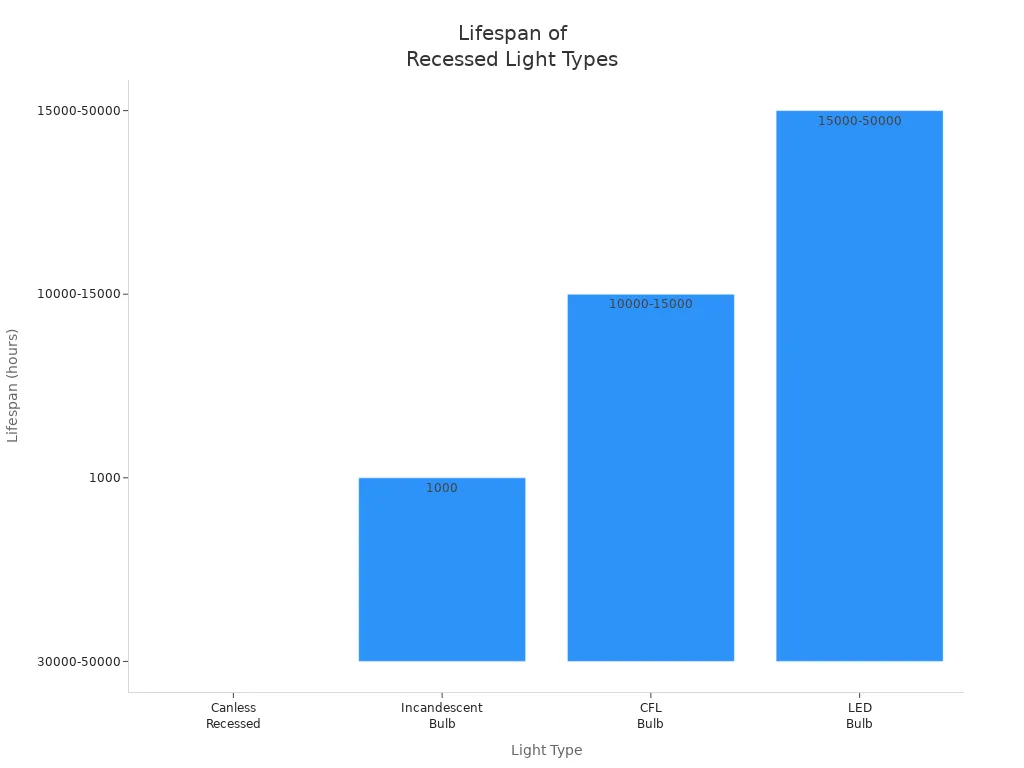
Note: Canless recessed lights give you years of bright, reliable light with almost no maintenance. Traditional recessed lights can last a long time, but you need to keep up with bulb changes to keep your room bright.
Best Uses
New Construction
You have more choices when building a new home. Builders like new construction recessed lights for these jobs. These lights attach to the frame before the ceiling is finished. You can plan where each light will go. This helps you avoid pipes and ducts. Traditional recessed lights work well in new homes. Canless models are good if you want a modern look. Retrofit can lighting is not common in new builds. You do not need to work around finished ceilings.
-
New construction recessed lights attach to the frame.
-
You plan your lights before drywall is put up.
-
Both types fit well in new homes.
-
Retrofit can lighting is not needed for new builds.
Tip: Make your lighting plan early when building.
Renovations & Retrofits
Updating an old home brings new problems. You need to check your ceiling and joists. Look for any pipes or ducts. Retrofit can lighting helps you add lights without big changes. You can put new lights into old drywall. Make sure your wires can handle the new lights. Pick colors that match each room’s feel. Dimmable and smart lights give you more control. Retrofit can lighting lets you mix different types of light. Always follow safety rules and local codes. Retrofit can lighting makes it easy to use energy-saving lights.
-
Check your ceiling before adding retrofit can lighting.
-
Pick the best color for each room.
-
Use dimmable or smart lights for more options.
-
Mix different lights for the best effect.
-
Follow safety rules and plan for upgrades.
-
Retrofit can lighting helps save energy and money.
DIY Projects
You can do many lighting jobs yourself. Canless recessed lights make DIY work simple. These lights are light and have built-in boxes. Cut a hole, connect wires, and snap the light in. Retrofit can lighting works for DIY but needs more steps. You must secure the can, wire it, and add the trim. Canless lights save time and keep things clean. Retrofit can lighting is good if you want to match old lights or need more styles.
-
Cut a hole for your light.
-
Wire the box.
-
Snap the light into the ceiling.
-
Canless lights do not need extra housing.
Note: Always turn off power and follow safety steps.
Modern Spaces
Modern homes need lights that look simple and save energy. Canless recessed lights fit this style well. They use LEDs, which use less power and make less heat. You get a thin, simple look that matches modern homes. Retrofit can lighting also works if you want to update old lights. Canless lights fit in small spaces and protect your ceiling. Retrofit can lighting lets you keep the look of old cans but add new features. Both types help you make your space bright and clean.
-
Canless lights give a simple, modern look.
-
Retrofit can lighting updates old lights for a fresh style.
-
Both types save energy and need less care.
-
You can use retrofit can lighting in small spaces.
Tip: Pick canless or retrofit can lighting for your modern home.
Product Example: Lumary Canless Recessed Lighting
Key Features
Lumary canless recessed lighting gives you many good features for your home. The lights are thin and look modern, so they fit most ceilings and save space. You can put them in easily because they have a junction box and spring clips. You do not need a big can or extra pieces. These lights use LED technology, so they are bright but do not use much power. You can change the color temperature from warm white (2700K) to cool white (6500K). You also get to pick from 16 million colors and more than 50 scene modes to match how you feel or what you are doing.
|
Feature |
Description |
|---|---|
|
Installation |
Easy, canless, includes junction box and spring clips |
|
Design |
Modern, ultra-thin, saves ceiling space |
|
Color Temperature |
Adjustable 2700K–6500K |
|
Color Options |
16 million colors, 50+ scene modes |
|
Brightness |
1000 lumens, 13 watts |
|
Control Methods |
Voice, app, Bluetooth remote |
|
Smart Compatibility |
Alexa, Google Assistant, Siri |
|
Usage |
Indoor rooms, DIY-friendly |
You can use these lights in bedrooms, kitchens, living rooms, or home offices. The flush mount style looks neat and matches any room.
Smart Home Integration
You can control Lumary lights in different ways. Use your voice with Alexa, Google Assistant, or Siri. You can also use the Lumary app or a Bluetooth remote. The app lets you set times, group lights, and change colors from anywhere. Dual Wi-Fi and Bluetooth help your lights work fast. You can make the lights change with music or games, so the colors move with the beat. The system works with other smart devices, so your home feels smarter and more fun.
-
Voice control with Alexa, Google Assistant, or Siri
-
App control for setting times, grouping, and color changes
-
Bluetooth remote for quick use
-
Music Rhythm Mode for fun lighting effects
-
No hub needed to set up
Tip: Smart lighting like Lumary makes your home easier to use and look better.
User Experience
People who use Lumary canless recessed lighting say it is easy and quick to install. You just follow the steps, connect the wires, and snap the lights in. Many users like the strong metal build and the bright, even light. You get lots of color choices, so you can set the mood for any time. Customers enjoy using voice commands and the app to control the lights. Reviews say the lights work well with smart home systems and are reliable. Some people think the app could be better, but most are happy and suggest Lumary to others who want smart lighting.
Note: You save time and get more control when you choose Lumary for your home lighting.
When picking between canless and traditional recessed lighting, think about what you need. Canless lights go in fast and use less energy. But you do not get as many trim choices. Traditional can lights have more styles and let you swap bulbs. Look at the table below to see the main things to think about:
|
Factor |
Canless Lights |
Traditional Can Lights |
|---|---|---|
|
Installation |
Quick and simple |
More complex |
|
Energy Efficiency |
Very high |
Depends on bulb |
|
Design Options |
Simple, modern |
Many trims and finishes |
|
Cost |
Lower overall |
Higher with add-ons |
Smart lighting like Lumary is easy to use. You can pick colors and get a modern style.
FAQ
What is the main difference between canless and traditional recessed lights?
You install canless lights directly into the ceiling. They do not need a metal can. Traditional recessed lights use a can that sits above the ceiling. Canless lights save space and work well in tight areas.
Can you install canless recessed lights in any ceiling?
You can install canless recessed lights in most ceilings. They fit well in places with little space above the ceiling. Always check for wires, pipes, or beams before you start.
Are canless recessed lights safe to use with insulation?
Yes, most canless recessed lights are IC-rated. This means you can place them in contact with insulation. Always read the product label to make sure.
Do canless recessed lights last longer than traditional ones?
Canless recessed lights use built-in LED chips. These often last 30,000 hours or more. Traditional lights depend on the bulb you use. LED bulbs in traditional cans can also last a long time.
Can you dim canless recessed lights?
Many canless recessed lights let you dim the brightness. You can use a compatible dimmer switch or a smart app. Always check the product details before you buy.


